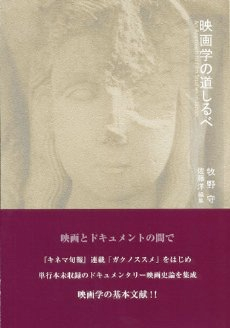There were two things that happened this fall revolving about Makino Mamoru that are worth noting. Makino, for those who don't know him, is the filmmaker, film historian, and collector who has not only produced important scholarship such as his history of Japanese censorship, but also collected materials essential for the study of Japanese film history. Markus Nornes and I edited a festschrift for him, In Praise of Film Studies, as well as dedicated our Research Guide to Japanese Film Studies to him.

The first big thing was the publication of a collection of his writings, Eigagaku no michishirube, by Bunsei Shoin. It was edited by Sato Yo, a fine young scholar who has been doing some excellent research on early film critics and helping Makino-san a lot recently. The book contains Makino's long-running work "Gaku no susume" that was serialized in Kinema junpo. It is a personalized account of the state of film studies in Japan, and Markus and I appear several times (even--ugh!--through photos!). The anthology also includes some of his other articles on documentary film history, proletarian film, film bibliography, and the history of Japanese film theory (a subject I am also working on: note the special issue of the RJCS). A complete table of contents is available on the Bunsei Shoin site. Markus and I also wrote short recommendations for the publication. Bunsei Shoin, by the way, is currently undertaking a full-color reprinting of all the issues of Kinema junpo from 1927 to 1940 (the period that has not been reprinted so far). This is a reprint that any library with a collection on Japanese film should have.
Here is the bibliographic information for the anthology:
- Makino Mamoru (author), Sato Yo (editor). Eigagaku no michishirube: An Approach to Film Studies in Japan (Tokyo: Bunsei Shoin, 2011)
- 牧野守著、佐藤洋編『映画学の道しるべ』文生書院、2011年。
- ISBN 978-4-89253-472-0
The other big thing was a symposium on November 11, 2011, commemorating the Makino Collection at Columbia. Entitled "The Makino Collection at Columbia: the Present and Future of an Archive," it featured scholars not only talking about how they have used Makino's monumental collection of materials (books, magazines, pamphlets, etc.) in their own research, but also how this archive can help found future research on Japanese cinema. I talked about Nakagawa Shigeaki and the Kyoto School of Film Theory (a topic dear to Makino's heart). Other presenters included Markus Nornes, Joanne Bernardi, Weihong Bao, Tomita Mika, Theodore Hughes, Ikegawa Reiko, and Oya Atsuko. It was put together by Beth Katzoff, who is undertaking the formidable task of cataloging the collection (a task that will take some time to complete). The Makino Collection will certainly be a treasure trove for future researchers, and if Columbia doesn't use it enough, certainly my students and I will.
Here is a link if you want to buy Eigagaku no michishirube on Amazon.jp:

